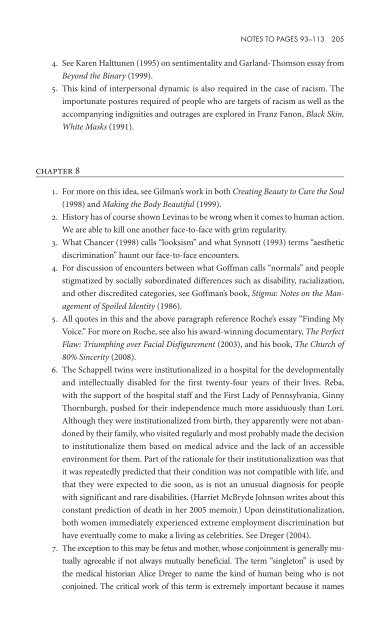Staring how we look sobre la mirada.pdf - artecolonial
Staring how we look sobre la mirada.pdf - artecolonial
Staring how we look sobre la mirada.pdf - artecolonial
Create successful ePaper yourself
Turn your PDF publications into a flip-book with our unique Google optimized e-Paper software.
98 SCENES OF STARING<br />
express emotions, thoughts, and character. Brows knit, mouths gape, lips<br />
grin, cheeks blush, jaws clench, eyes <strong>we</strong>ep, and pupils di<strong>la</strong>te with libidinal<br />
enthusiasm. Acts of perception are gestures. Eyes wink, gleam, glitter, twinkle,<br />
g<strong>la</strong>ze over, cut, make contact, pierce, penetrate, and assist the mouth in<br />
fashioning a frown or smile. Our agile eyebrows are “active little f<strong>la</strong>gmen of<br />
mind-state” (McNeill 1998, 199).<br />
Faces often reveal our roots and histories, as <strong>we</strong>ll. The shape of eye, nose,<br />
and lips, the texture of hair, and the pigmentation of skin are cues to racial<br />
and ethnic identity. Features are also tokens of our character or heritage.<br />
Noses are social emblems in stock figures such as Cyrano de Bergerac, Pinocchio,<br />
W. C. Fields, or the Jew. Ear shape, like that of noses, is taken as an<br />
index of character. Pitcher ears supposedly mark fools. Cesare Lombroso<br />
believed that criminals and prostitutes could be identified by the contours<br />
of the ear (Lombroso-Ferrero and Lombroso 1972). Moreover, <strong>we</strong> <strong>we</strong>ar our<br />
years, habits, and locations on our faces. Vestiges of age, drink, sun, diet,<br />
stress, illness, and hard <strong>look</strong>ing brand our noses, cheeks, foreheads, teeth, or<br />
eyes. Faces also bespeak our interiors. Characteristic facial features announce<br />
a Down syndrome perspective. Widely spaced eyes corre<strong>la</strong>te with schizophrenia.<br />
Bald men have more heart disease than the hirsutely headed. People who<br />
get polio tend to have <strong>la</strong>rge central incisor teeth (Zebrowitz 1997).<br />
So essential is the face to human interaction that it anchors much of our<br />
<strong>la</strong>nguage. Because humans turn to their own bodies to understand the world,<br />
our facedness provides a rich source of collective meaning. We call on the<br />
face to summarize complex ideas. Long, straight, poker, or iron faces express<br />
affect. An insult is a s<strong>la</strong>p in the face; futility renders us blue in the face; failed<br />
endeavors blow up in our face; defiance flies in the face; repentance is saving<br />
face; a betrayer is two-faced; the anonymous are faceless; friends and loved<br />
ones are familiar faces; the humiliated lose face; the embarrassed are shamefaced;<br />
the angry are in your face, the rejected must get out of our face; to<br />
enter the social world is to s<strong>how</strong> our face; to object <strong>we</strong> make a face. The orienting<br />
aspect of the face spins out into expressive verbs as <strong>we</strong>ll. Punishment<br />
is facing the music; honesty is facing up to it; confronting is facing it down;<br />
disagreements are face offs; damage is defacement. Individual facial features<br />
yield vivid and succinct expressions. We eye something <strong>we</strong> want, get an earful,<br />
nose around, keep our chins up, and put our noses to the grindstone. We<br />
can be cheeky, mouthy, or nosy. How our face <strong>look</strong>s is who <strong>we</strong> are.<br />
READING FACES<br />
Faces are consequential texts that <strong>we</strong> read attentively. Many of our enduring<br />
cultural icons are faces. Helen’s visage <strong>la</strong>unched the thousand ships that


